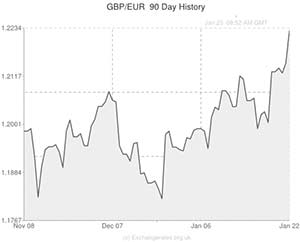
After dropping to a one-year low against the Pound yesterday, the Euro experienced a rebound in European trading as the services and manufacturing sectors of the Eurozone and its two largest economies kicked off 2014 more strongly than expected.
Although the French sectors contracted in January they shrank by less-than-forecast, with the measures gradually heading closer to the 50 mark separating growth from contraction.
Meanwhile, German manufacturing PMI came in at 56.3, up from 54.3 in December and better than the 54.6 forecast.
Similarly, the German services index edged up from 53.5 to 53.6 and the composite result inspired this statement from economist Oliver Kolodseike; ‘Germany’s private sector continued to hit high notes at the start of 2014, expanding at the quickest pace since June 2011. Manufacturing was a particularly bright spot, with companies reporting sharp and accelerated growth of output and new orders.’
The impressive growth in Germany helped the Eurozone’s composite PMI jump from 52.1 to 53.2 vs. expectations for a reading of 52.5.
The currency bloc’s private sector has now grown for seven consecutive months, with new orders rising and new orders/export orders and output recording the biggest monthly rise since early 2011.
These signs of improvement in the currency bloc allowed the Euro to enjoy its most impressive advance on the US Dollar for three months and rally against almost all of its most traded peers.
However, the results weren’t all positive. Employment remains a concern, and as Chris Williamson (chief economist at Markit) noted; ‘while gathering pace, the upturn remains fragile. Companies cut employment again and selling prices continued to fall amid still-weak demand. Deflationary forces are clearly a concern in many countries.’
Williamson continued; ‘The growth disparities are also a persistent concern. We are seeing growth being led in Germany, especially its surging manufacturing sector, while France looks likely to act as a drag on the Eurozone recovery for some time.’
Although the Euro advanced by 0.6 per cent against the US Dollar after the data was released the USD/EUR pairing could experience more movement following the publication of US initial jobless claims and existing home sales figures.
The EUR/GBP pairing is also likely to experience further volatility as a result of today’s consumer confidence report for the Eurozone and tomorrow’s UK BBA loans for house purchase figures.
Eurozone consumer confidence is expected to edge up from -13.6 to -13.0.
Euro Exchange Rates
[table width=”100%” colwidth=”50|50|50|50|50″ colalign=”left|left|left|left|left”]
Currency, ,Currency,Rate ,
Euro, ,Pound Sterling,0.8213,
,Pound Sterling,0.8213,
Euro, ,US Dollar,1.3634 ,
,US Dollar,1.3634 ,
Euro, ,Canadian Dollar,1.5203,
,Canadian Dollar,1.5203,
Euro, ,Australian Dollar,1.5503 ,
,Australian Dollar,1.5503 ,
Euro, ,New Zealand Dollar,1.6431 ,
,New Zealand Dollar,1.6431 ,
US Dollar, ,Euro ,0.7335,
,Euro ,0.7335,
Pound Sterling, ,Euro,1.2167,
,Euro,1.2167,
Canadian Dollar, ,Euro,0.6580 ,
,Euro,0.6580 ,
Australian Dollar, ,Euro,0.6552 ,
,Euro,0.6552 ,
New Zealand Dollar, ,Euro,0.6451 ,
,Euro,0.6451 ,
[/table]

Comments are closed.